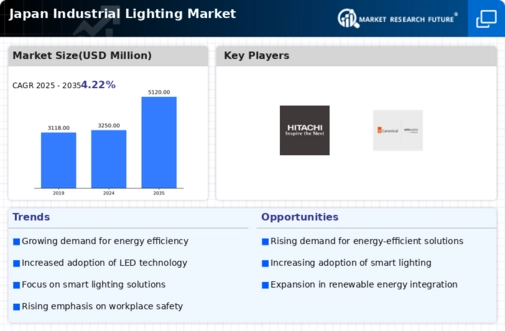Rising Industrial Automation
The trend towards industrial automation significantly impacts the industrial lighting market in Japan. As factories and warehouses increasingly adopt automated systems, the need for advanced lighting solutions that integrate seamlessly with these technologies becomes paramount. Automated lighting systems can adjust based on operational needs, enhancing efficiency and reducing energy consumption. The industrial lighting market is likely to see a shift towards solutions that support automation, with projections indicating a potential increase in market size by 15% over the next five years. This evolution reflects the broader trend of digitization in industrial operations.
Increased Focus on Workplace Safety
Workplace safety remains a critical concern for industries in Japan, significantly influencing the industrial lighting market. Adequate lighting is essential for ensuring safe working conditions, particularly in manufacturing and warehousing sectors. Enhanced visibility reduces the risk of accidents and injuries, prompting companies to invest in high-quality lighting solutions. The industrial lighting market is responding to this need by offering products that meet stringent safety standards. As organizations prioritize employee well-being, the demand for reliable and effective lighting systems is expected to rise, further propelling market growth.
Growing Demand for Energy Efficiency
The industrial lighting market in Japan experiences a notable surge in demand for energy-efficient solutions. As industries strive to reduce operational costs and minimize environmental impact, energy-efficient lighting systems, particularly LED technology, gain traction. Reports indicate that energy-efficient lighting can reduce energy consumption by up to 70%, which is particularly appealing to manufacturers and facility managers. This shift not only aligns with Japan's commitment to sustainability but also enhances productivity by providing better illumination. The industrial lighting market is thus witnessing a transformation as companies prioritize energy savings, leading to increased investments in advanced lighting technologies.
Government Initiatives and Incentives
Government policies and initiatives aimed at promoting energy efficiency and sustainability are shaping the industrial lighting market in Japan. Various programs provide financial incentives for businesses to adopt energy-efficient lighting solutions, thereby reducing initial investment barriers. The industrial lighting market benefits from these initiatives, as they encourage the transition to modern lighting technologies. Additionally, regulatory frameworks that mandate energy efficiency standards compel industries to upgrade their lighting systems. This regulatory environment fosters a competitive landscape, driving innovation and investment in the industrial lighting sector.
Technological Advancements in Lighting Systems
Technological innovations play a pivotal role in shaping the industrial lighting market in Japan. The advent of smart lighting systems, which incorporate IoT and automation, enhances operational efficiency and user experience. These systems allow for real-time monitoring and control, enabling businesses to optimize energy usage and reduce costs. The industrial lighting market is likely to see a compound annual growth rate (CAGR) of approximately 8% over the next few years, driven by these advancements. Furthermore, the integration of sensors and adaptive lighting solutions contributes to improved safety and productivity in industrial environments.












Leave a Comment